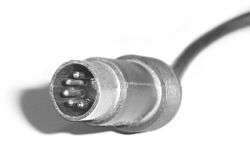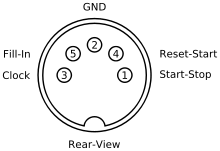DIN sync


The DIN sync standard, also called Sync24, defines an interface for electronic music instruments.
Definition and history
It was introduced in the early 1980s by Roland Corporation for the synchronization of music sequencers, drum machines, arpeggiators and similar devices. It has since been superseded by MIDI, in the mid to late 1980s. The DIN sync standard consists of two signals, clock (tempo) and run/stop. Both signals are TTL compatible, meaning the low state is 0 V and the high state is about +5 V.
The clock signal is a low frequency pulse wave suggesting the tempo. Instead of measuring the waveform's frequency, the machine receiving the signal merely has to count the number of pulses to work out when to increment its position in the music. Roland equipment uses 24 pulses per quarter note (PPQN for short), known as Sync24. Therefore, a Roland compatible device playing sixteenth notes would have to advance to the next note every time it receives 6 pulses. Korg equipment uses 48 pulses per quarter note.
The run/stop signal shows whether the sequence is playing or not.
The DIN sync standard is so named because it uses 5 pin DIN connectors, the same as used for MIDI. DIN sync itself is not a DIN standard. Note that despite using the same connectors as MIDI, it uses different pins on these connectors (1, 2, and 3 rather than MIDI's 2, 4 and 5), so a cable made specifically for MIDI won't necessarily have the pins required for DIN sync physically connected via wires. In some applications the remaining pins (4 and 5) are used as "tap", "fill in" or "reset and start", but this differs from one device to another.
| Pin | Purpose | Notes |
|---|---|---|
| 1 | start / stop | stop = 0 volt, start = +5 volt |
| 2 | ground | |
| 3 | clock | symmetric pulse wave 0/+5 volt, the positive slope determines the clock step |
| 4 | reset start | optional; same voltages as start/stop; the reset is valid for the song mode of Roland machines |
| 5 | fill in | optional; same voltages as start/stop; it activated the fill in function of the TR-808 and TR-606 |
If a device is a DIN sync sender, the positive slope of start/stop must reset the clock signal, and the clock signal must start with a delay of 9 ms.[1]
A detailed description on how to implement a DIN sync sender with Play, Pause, Continue and Stop functionality was published by E-RM Erfindungsbuero.[2]
Relation to other clock systems
Other clock systems
The MIDI interface uses the same connectors, but is electrically not compatible with DIN sync. The MIDI protocol contains MIDI clock (also known as MIDI beat clock). MIDI clock also works with 24 "ticks" per quarter note (one tick corresponds to one nibble of the protocol).
"Analog clock" signals are equivalent to the clock signal at pin 3 of DIN sync interface. The clock rate is usually higher than the DIN sync's rate. Typical values are 48, 96 or 192 pulses per quarter note (examples: Oberheim DMX, DX, DSX; Linndrum 1 and 2).
"Analog trigger" signals transfer a pulse per musical event. For instance a trigger corresponds to a step of an analog sequencer or an arpeggiator, a step in a rhythm pattern. Typical analog triggers run at four pulses per quarter note.
Combining DIN sync with other clock systems
The combination of DIN sync with a different clock system can be achieved either by converting the format and / or the clock rate (see list below) or by using a central unit (so called master clock), which provides multiple clock formats. The approach with a masterclock is usually chosen, especially if a synchronization with absolute time is required, such as synchronisation with a tape recorder or with video footage.
Typical devices which can act as a master clock and provide DIN sync include the Roland SBX-80, Roland SBX-10, Friendchip SRC, E-RM midiclock⁺ and Yamaha MSS1. Many drum machines which have DIN sync and MIDI clock outputs can act as master clock for those two formats.
Converting DIN sync from and to other clock systems
Though DIN sync and MIDI clock have the same clock rate, they require a conversion of the format within a microprocessor or similar. The conversion from MIDI clock to DIN sync is available in many industrial devices. For the conversion from DIN sync to MIDI clock there is at the moment only the device 'Sync-Split2' of the company Innerclock Systems. Also two no longer produced devices do this type of conversion: Roland SBX10, Korg KMS30. On September 1st 2014, Roland introduced the SBX-1 which provides MIDI to sync24 or sync48 conversion.
To get an analog trigger or clock from the DIN syncs clock signal one has to use digital frequency division or frequency multiplication. There are no dedicated industrial devices which provide a division. The Roland SBX10 can convert into a 48, 96, and 120 PPQN clock.
Devices with DIN sync
Some devices have a DIN sync input as well as DIN sync output, other device have only a single DIN socket which sometimes can be switched between input and output.
| Company | Model | In / Out | PPQN | Remark |
|---|---|---|---|---|
| Abstrakt Instruments | Avalon | In and out | 24 | Conversion between MIDI & DIN sync, can output both simultaneously |
| Acidlab | Bassline | Switchable | 24 | |
| Adafruit | x0xb0x | Switchable | 24 | Converts DIN sync to MIDI and MIDI to DIN sync |
| Arturia | Minibrute | In and out | 24/48 | 1PPS, 2PPQ, DIN24, DIN48 or analog clock (Note: Arturia Drumbrute offers DIN sync, Minibrute does not appear to support DIN) |
| audiowerkstatt | din2midi2din | In and out | 24/48 | Conversion from MIDI to DIN sync and DIN sync to MIDI (sync24/sync48) |
| audiowerkstatt | din-restarter | In and out | 24/48 | Tool for synchronized start/stop of DIN sync devices (sync24/sync48) |
| Doepfer | M.A.U.S.I. | Out only | Conversion from MIDI to DIN sync, a division factor can be set | |
| Doepfer | MCV-24 | Out only | Up to 24 | Conversion from MIDI to DIN sync, a division factor can be set |
| Doepfer | MSY2 | Out only | 1.5 to 24 | Conversion from MIDI to DIN sync, a division factor can be set between 1:1 and 1:16 |
| Elektron | Analog Four / Analog Four MKII / Analog Keys | Out only | 24/48 | MIDI Out jack and/or MIDI Thru jack can be set up to output DIN sync24/sync48 |
| Elektron | Analog Rytm / Analog Rytm MKII | Out only | 24/48 | MIDI Out jack and/or MIDI Thru jack can be set up to output DIN sync24/sync48 |
| Elektron | Analog Heat | Out only | 24/48 | MIDI Out jack and/or MIDI Thru jack can be set up to output DIN sync24/sync48 |
| Elektron | Digitakt | Out only | 24/48 | MIDI Out jack and/or MIDI Thru jack can be set up to output DIN sync24/sync48 |
| E-RM Erfindungsbüro | Midiclock⁺ | Out only | 4, 24 | Switchable MIDI / sync out jack can be set up to output sync24 or analog clock (4 PPQN) |
| Future Retro | Mobius | Out only | 24 | Provides MIDI to DIN sync conversion |
| Future Retro | Revolution | Out only | 24 | Provides MIDI to DIN sync conversion |
| JoMoX | XBase09 | Switchable | 24 | |
| Kawai | R-100 | Switchable | ||
| KOMA Elektronik | RH301 | In and out | 24 | sync24; converts MIDI & analogue clock to DIN sync and DIN sync to MIDI and analogue clock |
| Korg | KPR-77 | Switchable | 48 | |
| Korg | DDM-110 | Switchable | 48 | |
| Korg | DDM-220 | Switchable | 48 | |
| Novation | DrumStation | Out only | 24 | converts MIDI clock to DIN sync |
| Roland | MC-202 | In and out | 24 | |
| Roland | MC-4 | Switchable | Various | |
| Roland | MPU-401 | Out only | 24 | |
| Roland | TB-303 | In only | 24 | The TB-303 has a switch in the DIN socket, which disables the internal clock and enables the external DIN sync. DIN Sync out can be achieved unofficially, if the DIN connector is inserted not completely in the socket. |
| Roland | TR-606 | Switchable | 24 | two trigger outs via programming of the toms |
| Roland | TR-707 | Switchable | 24 | trigger out via programming of the rimshot, no conversion from MIDI clock to DIN sync! |
| Roland | TR-727 | Switchable | 24 | trigger out via programming of the agogo bell, no conversion from MIDI clock to DIN sync! |
| Roland | TR-808 | Switchable | 24 | three trigger outs via programming of cowbell, clap, and accent |
| Roland | TR-909 | In only | 24 | trigger out via programming of the rimshot |
| Roland | CSQ-600 | Out only | 12 | provides also the a special CSQ-Clock, and clock for the CR-78 (12 PPQN) |
| Roland | Jupiter-8 | In only | 12 | for synchronizing arpeggio |
| Roland | MSQ-100 | In and out | ||
| Roland | MSQ-700 | In and out | ||
| Sequentix | P3 | Out only | 24 | MIDI Sync Out can be modified to output DIN sync24 |
| Tama | TSQ-1000 | Switchable | this is trigger sequencer which provides six trigger tracks | |
Note that sync48 devices can be combined with sync24 devices, if 32nd notes are programmed instead of 16th notes.
See also
External links
References
- ↑ See service manual TR-808, Fig.8 and Fig.9
- ↑ E-RM Erfindungsbuero DIN sync report